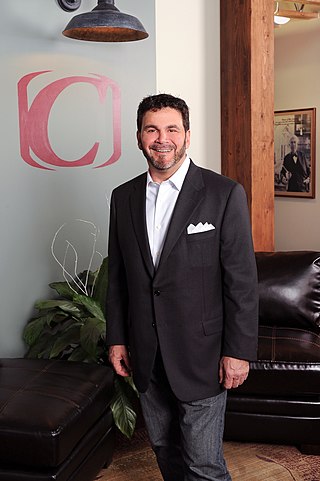
Advertising is the practice and techniques employed to bring attention to a product or service. Advertising aims to present a product or service in terms of utility, advantages and qualities of interest to consumers. It is typically used to promote a specific good or service, but there are a wide range of uses, the most common being commercial advertisement.
An infomercial is a form of television commercial that resembles regular TV programming yet is intended to promote or sell a product, service or idea. It generally includes a toll-free telephone number or website. Most often used as a form of direct response television (DRTV), they are often program-length commercials, and are typically 28:30 or 58:30 minutes in length. Infomercials are also known as paid programming. This phenomenon started in the United States, where infomercials were typically shown overnight and early morning, outside peak prime time hours for commercial broadcasters. Some television stations chose to air infomercials as an alternative to the former practice of signing off, while other channels air infomercials 24 hours a day. Some stations also choose to air infomercials during the daytime hours, mostly on weekends, to fill in for unscheduled network or syndicated programming. By 2009, most infomercial spending in the U.S. occurred outside of the traditional overnight hours. Stations in most countries around the world have instituted similar media structures. The infomercial industry is worth over $200 billion.

Direct marketing is a form of communicating an offer, where organizations communicate directly to a pre-selected customer and supply a method for a direct response. Among practitioners, it is also known as direct response marketing. In contrast to direct marketing, advertising is more of a mass-message nature.
Joseph Myron Segel was an American entrepreneur. He was the founder of over 20 American companies, most notably QVC, an American television network, and the Franklin Mint, a producer of mail-order collectibles. Segel was named to the Direct Marketing Association's Hall of Fame in 1993. He was honored with a Lifetime Achievement Award from the Electronic Retailing Association and an honorary doctorate from Drexel University.
ShopTV Canada was a Canadian English language cable television direct response television shopping service owned by Torstar Media Group Television.
Direct response television (DRTV) is any television advertising that asks consumers to respond directly to the company — usually either by calling a toll-free telephone number, sending an SMS message, or by visiting a web site. This is a form of direct response marketing.
Ginsu is a brand of direct marketed knives. The brand is owned by the Douglas Quikut Division of Scott Fetzer, a Berkshire Hathaway Company. The brand was heavily promoted in the late 1970s and 1980s on U.S. television by using infomercials characterized by hawker and hard sell pitch techniques. The commercials generated sales of between two and three million Ginsu sets between 1978 and 1984.

Proactiv is an American brand of skin-care products developed by two American dermatologists, Katie Rodan and Kathy A. Fields, and launched in 1995 by Guthy-Renker, a California-based direct marketing company, that was endorsed by famous celebrities. The range includes moisturizers, body washes and treatment products, but the brand is known for its three-step anti-acne Solutions 3-step routine consisting of a BPO cleanser, glycolic toner and treatment lotion. Proactiv+, a reformulation of the three-step kit, was introduced in 2013, and in 2017, ProactivMD launches powered by Adapalene.
Advertising research is a systematic process of marketing research conducted to improve the efficiency of advertising. Advertising research is a detailed study conducted to know how customers respond to a particular ad or advertising campaign.

The following outline is provided as an overview of and topical guide to marketing:
Marketing Mix Modeling (MMM) is a forecasting methodology used to estimate the impact of various marketing tactic scenarios on product sales. MMMs use statistical models, such as multivariate regressions, and use sales and marketing time-series data. They are often used to optimize advertising mix and promotional tactics with respect to sales, revenue, or profit to maximize their return on investment.
Guthy-Renker is a California-based direct-response marketing company that sells health and beauty products directly to consumers through infomercials, television ads, direct mail, telemarketing, e-mail marketing, and the Internet. Many of its products are endorsed by celebrities, including actresses and musicians.

Alvin Maurey Eicoff was widely recognized as a founder of direct response television (DRTV) advertising. He helped pioneer the use of “1-800” numbers on television, along with the phrase “or your money back”. Alvin was a proponent of short-form DRTV, which consisted of 120-second and 60-seconds commercials featuring a 1-800 number and a call to action.
Ajit "A. J." Khubani is an American inventor, entrepreneur and marketing executive. Known as the "Infomercial King," Khubani is the founder and CEO of the infomercial firm Telebrands and a pioneer of the infomercial industry. He is the creator of the original "As seen on TV" logo and category at retail.

JML is a consumer product company based around the UK specialising in the promotion of products in retail stores with video screens.
Eicoff is one of the top ten advertising agencies in Chicago. It specializes in direct response television (DRTV) advertising. It is known as the firm that popularized 1-800 call numbers and claims to have coined the "… or your money back" catchphrase.

Frank Cannella is a businessman and philanthropist, known for his work in the infomercial industry. In 1999 People Magazine labeled him as a pioneer in the infomercial industry and in April 2013 Cannella was inducted into the Direct Response Television Hall of Fame. Cannella formed Cannella Response Television, which handled the 1990s Tae Bo exercise video infomercials advertising campaign.
Gregory Renker, is best known for cofounding Guthy-Renker with partner Bill Guthy. He was born in Phoenix, Arizona in 1957 and had eight siblings. Growing up, Renker's family moved a lot due to his father's work managing country clubs and hotels. Renker worked his way through college at San Diego State University and married Stacey Renker several years later.
The Star Television Network, was an attempt, though unsuccessful, at a fifth television network based in Orlando, Florida. The network was notable as the first television network to have featured exclusively direct response commercials and infomercials among standard programming.

DRUM Agency was an independently owned marketing agency with operations in Atlanta, New York City and Chicago. It shut down without notice on April 15, 2020. It was the result of the merger of BKV, unified.agency, Hiccup and Umarketing firms. The oldest agency, BKV, originally specialized in direct response marketing, then later expanded into traditional media, followed by digital media. Clients included both for-profit businesses and nonprofit organizations.








